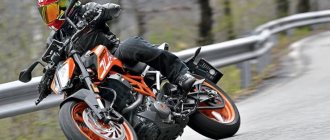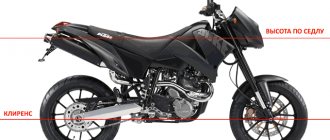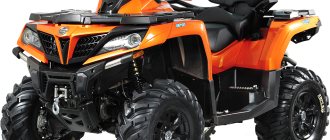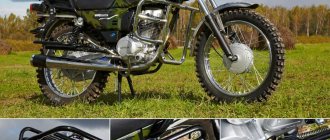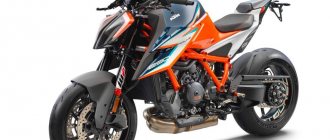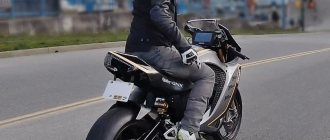Test drive KTM990 Super Duke
The following text tells about the complex character of the impulsive Austrian nobleman, as well as about his adventures around the glorious city of Kharkov in the company of a motorcycle journalist, a photographer, his overlord, and one beautiful lady who joined our noble company a little later.
The acquaintance with “Sir Duke” took place on a warm and clear May day. Of course, I knew him in absentia for quite a long time. Ever since the model was launched into production. Even then, he attracted my attention with his non-trivial appearance, which showed the character of a street fighter, but certainly not a respectable nobleman. “If this is a duke, then he’s probably a warlike one,” I thought then. During a personal meeting, my guesses were only confirmed. It not only looked, but also sounded and rode like a real street fighter. But, more on that later.
In the meantime, the overlord of this KTM (that is, the owner) handed me the keys to his bike, and in return received a bunch of my 990 Adventure. By the way, this brought additional interest - it was possible to compare the characters of such similar, but at the same time so different motorcycles on the spot.
In the chest of the Super Duke beats a fiery 999 cc “V”-shaped “heart” with two cylinders, which produces 118 hp. and 100 nm. Yes, the indicators are not fantastic, but this is usually enough for all occasions of city life. Moreover, the well-known principle also applies here: “the main thing is not the size, but the ability to use it.” Well, there are all the conditions for this. In its arsenal, among other things, there is a rigid tubular space frame, first-class White Power suspension, Brembo calipers, radial brake and clutch machines...
At this moment, a photographer joined our company.
- How do you like the bike? – I asked.
- ABOUT! Wow! “He assured me soulfully.
Turning the key in the ignition and pressing the starter button, I even froze for a moment. As expected, Sir Duke started up right away. He was angry and loud. He demanded glory, exploits and destruction. Moreover, he wanted destruction much more than glory and exploits.
While the bike was shaking with anticipation and anger, I got used to the new place. The Super Duke is not low at all - its seat height is 855 mm, which is only 5 mm less than my Adventure. But he is quite skinny. My knees, instead of tightly hugging the tank, sank somewhere and met the hard plastic only somewhere about the width of the saddle. In an instant, I felt like I was sitting on a moped, and not on a “liter” streetfighter, which would have no difficulty in blasting at 240 km/h. However, the sensation did not last long and left behind only a hint of the lightness of the structure.
All buttons, switches, knobs and levers fully correspond to the average motorcyclist's notions of good ergonomics. The instrument panel here is similar to that on the Adventure, and shows speed, engine temperature, revs, mileage, time, and also has the traditional handful of warning lights. Having squeezed out the moderately soft clutch with a hydraulic drive and a radial machine, I stuck into first gear. I release the left lever, add gas, and Sir Duke is already rushing headlong to fight windmills (or is this from another fairy tale?).
The honorary escort, apparently, was slightly unprepared for such agility of a noble person and noticeably lagged behind.
Already at the very beginning, a family line clearly emerged. The fact is that KTM engines of the LC8 series operate rather roughly, and at the “low speed – idle” border the engine goes into “on-off” mode. The Austrian, unlike the Japanese, does not allow the weight to be weighed out in milligrams, plodding along at walking speed. He cuts from the shoulder: if you’re already going, then go! If you want to plod along, then press the clutch.
However, the motorcycle feels great when cutting through city traffic jams. Innate thinness, combined with a large steering turn and torque available from the bottom, make it possible to move quite dynamically even in a city crowded with cars. The mirrors do not protrude beyond the wide steering wheel, so they do not cause inconvenience when seeping into the cracks between “tin cans” firmly stuck in traffic jams. Well, the fact that you can clearly see only your own shoulders and elbows in them, and the picture blurs with increasing speed - that’s the tenth thing. After all, our impulsive “sir” is particularly direct and decisive, not inclined to look back and worry about the past.
The motorcycle's handling is close to the standard for this class. It does not taxi or stubbornly turn, placing full power and responsibility on the pilot. Thanks to its rigid chassis and fairly sharp steering geometry, it reports wheel position with millimeter precision. More than once I had the feeling that I was holding my hands not on the steering wheel, but directly on the front axle. In addition, this “sir,” despite all his ardor and categoricalness, instantly responds to the demand to change course. The main thing for him is to move forward. And “forward” is where the front wheel is pointing.
On our, to put it mildly, not ideal roads, I had the opportunity, sorry, to feel with my ass the rigid calibration of the suspensions, clearly designed for the smooth asphalt of “developed countries”. We must give it its due - during acceleration and braking, when both wheels alternately came off the asphalt and began to scratch along the tops of the bumps, the bike did not show the slightest bit of instability, remaining completely predictable and controlled by the will of the pilot.
Soon the stuffy and dusty city was left behind, the last traffic light gave me a friendly green wink, and a moderately broken country road stretched ahead. Having stuck into first gear, I boldly opened the gas and felt that the rear wheel began to overtake the front. The latter, in turn, hovered in the air for a couple of seconds and gently sank down. Second gear... Before the fork had time to load properly, powerful acceleration threw it up again. The third... no, we can’t expect miracles - the front end has become noticeably lighter, but remains in contact with the surface. Having clicked up a few gears, I rolled more calmly - after all, it was a road, not a race track.
Hmmm... the Super Duke engine is not only noticeably faster than its detuned Adventure counterpart, but also vibrates noticeably more. However, it is not so easy to get rid of vibrations from a V-twin with a cylinder camber of 70 degrees. Or rather, it’s even more difficult to say: extremely difficult. The pilot can only come to terms with them, relax as much as possible, and have fun. The girls, at least, like it.
A more measured pace of riding allowed me to pay attention to my feelings and the general behavior of the motorcycle. The fact that noticeable kicks were transmitted to me through the suspension was not news for a long time, but hints of wobbles when driving through particularly obvious defects in the surface (although Ukrainian roads are one continuous defect) became an unpleasant discovery for me and made me think that the steering The damper is, in general, a pretty necessary thing.
The number “130” was stuck on the speedometer and I didn’t want to accelerate any further. At approximately this speed, the oncoming air flow became very noticeable, and the steering wheel acquired some resemblance to a horizontal bar, on which you had to pull yourself up so as not to slide into the passenger seat.
Oleg buzzed past me, having transferred to my Adventure. “It’s good for him, I thought - he’s driving, enjoying good wind protection and the complete indifference of the equipment to the quality of the surface, and here I’m clicking my teeth on the bumps”...
To my and “Sir Duke’s” joy, the hegemony of his overlord did not last long, because the chipped asphalt ended, giving way to the still good surface of a deserted highway.
I begin to accelerate, cheerfully clicking the gearbox foot. Before I knew it, the “superduke” ran up to 170 km/h. After this mark, the flashing numbers on the speedometer slowed down somewhat, and the wind intended to tear me away from the horizontal bar. At around 200 km/h, the front fork began to unload, introducing a note of instability into the handling. At 220 it became scary, and my right hand, against my will, closed the gas. Straightening up, I pressed on the front brake. Thanks to reinforced hoses and a radial machine, 4-piston Brembos paired with 320 mm discs create a very powerful and predictable deceleration, behavior in high-speed turns was felt at road junctions under the close supervision of a photographer. Straight seating position, narrow silhouette at the knees, horizontal bar handlebars... all this began to make me think of a supermoto. I even wanted to tilt my body in the opposite direction, put my foot out, drop two or three gears down, release the clutch and hear the fractional squeak of the rear wheel going into a skid... Ahem! I was daydreaming about something. In general, I had to hang into the corner like a road and tumble into it over and over again, gradually increasing the speed. The bike behaved superbly, demonstrating precise and sword-sharp handling. The pilot does not have to make any effort to maintain the chosen trajectory, but if he suddenly decides to change course, then this will require a minimum of body movements.
Suddenly, at the exit of the next “take”, I felt that the rubber “floated”, hinting at an imminent loss of grip on the asphalt. But the angle of inclination was very small... What's the matter? The Pirelli Diablo Corsa tires were warm and soft to the touch and the pressure was normal. Maybe there's something wrong with the asphalt? This is true. In the place where I rode, the road surface turned out to consist of rolled bitumen and large stones, which were perfectly polished by the wheels of passing cars. Here's the skating rink... It might be interesting here in the rain.
Although we didn’t get to experience the onset of darkness on the highway, I can say a lot about the head light. After all, the Super Duke has the same headlight that is on my Adventure. On the “near” side the lower lamp is lit, on the “far” one the second one is connected, illuminating an additional section of the road. As a rule, this is enough for almost all occasions, so lighting technology deserves a solid “four”.
So who are you, Sir Duke? A desperate street fighter with the title of Duke, or a purebred nobleman, driven by a thirst for battles, exploits and glory? Probably, as always, something in between.
Passenger's opinion: Alisa Shevtsova
It’s probably worth starting with how to saddle this iron horse: the footrests are quite high, so I had to lift my leg well to reach the first (I’m 164 cm tall) and not miss the second.
Well, what did it cost the manufacturers to lower the footpegs 10 cm lower?.. But, as far as I understand, very few manufacturers of such motorcycles care about the comfort of passengers - that is not what they are intended for.
When I sat down, I felt that my legs were unusually bent at the knees. Another inconvenience was the very close proximity of the legs to the exhaust pipes, which can sometimes have a fairly high temperature.
The next stage is to set off. No special vibrations are felt when moving, noise effects are quite within acceptable limits, I can’t say that the seat is soft enough, but, in general, it’ll do.
When I finally found a comfortable position and relaxed my legs in an unusual position, it became possible to notice other features. For example, something that, when accelerating quickly, carries you backwards, and when braking sharply, you fall completely on the driver, and the inertia lifts your legs off the pegs. The high position of me in the seat does not allow me to press close to the driver and hug him tightly enough to feel completely comfortable and safe. But at higher speeds (somewhere on a country road) the feeling is quite pleasant, especially if you position your head correctly so as not to create unnecessary aerodynamic drag. In this case, even 130 km/h is perceived quite calmly. There is no discomfort when cornering. By the way, getting down is just as high as climbing.
It seems to me that an unprepared person will first have to get used to it and find his place, and then everything will be fine.
Text: Sergey Kuznetsov
Photo: Ilya Pshenichny
The motorcycle was provided for testing by: Oleg Korlyakov
The Austrian company KTM is one of the largest and most famous manufacturers of sports motorcycles in Europe. The official founding date of the company is 1934. It was then that a young but very ambitious engineer named Hans Trunkenpolz, who lived in the city of Mattinghofen, opened a metal processing workshop, which received the difficult name for a Russian person Kraftfahrzeuge Trunkenpolz Mattighofen (KTM).
At first, the young entrepreneur did not succeed in everything, but literally a few years after the start of commercial activity, he began to earn a stable income. And almost 20 years later, already in 1953, Trunkenpolz managed to begin the serial assembly of small motorcycles and mopeds, which were equipped with 2-stroke engines purchased from other developers.
Paying attention to the local success of a small company, which consisted of only a few dozen employees who jointly assembled three motorcycles a day, successful businessman Ernst Kronreif acquired a controlling stake in the company and became its main shareholder. Of course, after this the company received an updated name, which included the name of the new co-owner. However, this did not affect the abbreviation. It remains the same – KTM (Kronreif & Trunkenpolz Mattighofen).
The reorganized enterprise continued to assemble light motorcycles, and therefore was able to gain a decent share of the Austrian market. The cost of KTM products was more than acceptable, because the motorcycles of this company were excellently bought up by representatives of the middle class, among whom there were always a lot of people interested.
The systematic development of the enterprise continued until the end of the 60s. But the course of history was changed by the company’s specialists developing their own engine. It was then that the essence of Kronreif & Trunkenpolz Mattighofen's existence ceased to be reduced to assembling motorcycles from parts produced by other developers. Moreover, almost immediately, several debut models of the company were presented simultaneously, among which the off-road version, as well as a powerful sports bike, especially stood out.
In the early 70s, the KTM sports model turned out to be so successful that the company had to seriously engage in the sports component of motorcycle production. And it immediately bore fruit. In 1974, Soviet rider Gennady Moiseev, representing the KTM team, became the world motocross champion in the 250 cubic centimeter class. This was only the first success of the company, which was subsequently repeated many times. Moiseev alone won the championship twice more - in 1977 and 1978.
In the 80s of the last century, work on the layout of motorcycles continued actively. In the second half of the decade, KTM representatives managed to introduce several completely new principles of motorcycle operation, thanks to which the popularity of Austrian developments continued to grow.
However, 1989 put an end to the rapid development of the enterprise. The end of the “golden era” is usually associated with the death of the founder and main ideologist of the company, Hans Trunkenpolz. Almost immediately, KTM began to have serious problems, resulting in the company going bankrupt in 1991. However, the competence of the company's new management helped the Austrian motorcycle manufacturer get out of the hole.
In 1992, the company was divided into three companies: KTM Sportmotorcycles GmbH (production of sports motorcycles), KTM Fahrrad GmbH (production of bicycles) and KTM Kuhler GmbH (production of radiators). Almost immediately the company began its revival. And the marketing department of the sports department has completely developed a new operating philosophy (“Ready for the Race”). According to this principle, each of the KTM models had to undergo a full test of readiness for sports competitions before leaving the factory. Thus, each motorcycle produced by KTM can be called a full-fledged sports bike, tested by a professional racer.
The beginning of the new century turned out to be no less successful for the company than the end of the old: already in 2000, riders on KTM motorcycles won championship titles in the 125 and 500 cubic centimeter classes, as well as a host of other competitions. At the same time, the company presented to the public a prototype of the first motorcycle in the company's history, equipped with a 1000 cc engine.
2005 marked the beginning of KTM's market expansion in North America. In addition, it was in 2005 that the Austrian company made its debut in Russia. According to official data, by that time the level of production and sales of the enterprise had increased significantly. About 400 motorcycles rolled off the company's factory lines per day (about 135,000 per year), while sales volumes amounted to about 80,000 motorcycles in one calendar year (of which 35,000 were sold in the United States).
In 2007, KTM expanded. It included such manufacturers of motorcycle equipment as Husaberg AB (Sweden) and WP Suspension (Netherlands). At the same time, the development department did not forget about introducing new products. Over the past few years, road bikes have debuted with the Duke 690, Super Duke 990, and the Superbike 1190 RCS. All of them seemed so successful to specialists that even before their debut they were “doomed” to success. Just like ATVs and minicycles (motorcycles with an engine capacity of 50-85 cubic centimeters), which the company also began producing just a few years ago.
Read more
KTM 990 Supermoto SM-T/KTM 990 Supermoto SM-R: Terrier and Doberman
The Austrian company knows a lot about SUVs. The other, well-known Italian one, has long been famous as a first-class manufacturer of road bikes. But look what's happening! To Ducati! Last year, 92,385 units of motorcycles were produced (which, by the way, is a record in the history of the company), and, please note, 15,000 of them were not just anything, but V-twin street bikes. Two recent new products in this category - Supermoto SM-T and SM-R - were presented last fall in Milan. This is, one might say, right at the gates of the Ducati factory.
The KTM 990 Supermoto SM-T is an adventure tourer. “When we start a new project, the first thing we ask is: how will the KTM “genes” affect the debutant? — Stefan Pierer, the president of the company, told me. “We immediately decided that a traditional sports tourer would not suit us: our customers are waiting for something truly sporty!” And what did the buyer see at the exit? A competitor for the Triumph Tiger or Suzuki V-Strom (but not for the BMW R1200GS, since the off-road potential of the new KTM is minimal: the lugs of the Continental ContiSport Attack tires are very small).
You sit down in its not-so-low (855 mm) saddle and suddenly discover for yourself: the seating position is comfortable! At least now on a long journey. A 19-liter gas tank will eliminate the need to “bow” to almost every gas station. The tubular frame made of chrome-molybdenum steel weighs... only 9.8 kg. An aluminum subframe supports a surprisingly comfortable two-seater saddle. The upside-down WP fork offers 160mm of wheel travel (so bumps won't bite you) and is set at a moderate 24.4 degrees, while the wheelbase (1505mm) isn't too long for a road machine. Due to the above-mentioned features, the SM-T has fairly sharp handling, but without excessive “nervousness.”
During the test, I drove along the winding roads of southern Portugal. The quality of their coating varied greatly - from chipped to excellent, so K and I have everything. I’ll take the liberty of saying: this is a fully multi-purpose bike.
Even the heavy rain in the morning did not dampen the elation. However, it’s a sin for a test pilot to complain about rain: it only helps to better assess the capabilities and inclinations of the motorcycle. I really liked how the torque gently increases after starting from a standstill (“twos” K has not been different until now). The steering wheel is wide, but not too wide; it provides good leverage in tight turns. I’m sitting high up, looking over the cars in city traffic. The windshield provides quite acceptable protection up to speeds of 170 km/h. On the freeway I managed to squeeze out “all two hundred”... I had to bend down, but the wind still ruffled my shoulders mercilessly. Overall, it’s a very practical car: you’ll quickly get where you need to go on the highway, and you’ll have fun on narrow mountain roads. (“Practical KTM”? Sounds just like a “comfortable sportbike”!)
The rain also put the Continental tires to the test - and they stood up to it surprisingly well. At first, before the start, when I was just “feeling” it with my eyes, I looked at the tread skeptically... But while driving, the seemingly shallow grooves drained the water well, and the front tire tenaciously “held” the asphalt. There was no nervous tension when braking on a wet road. The rear tire began to “walk” during sharp acceleration. It would have been possible to “suppress” this matter, but I was too lazy to tinker with the suspension settings... Then the road dried up, and I could attack the turns with no less fanaticism than on the Superduke. And besides, SM-T compared to Duke... What is this word that you never expect to hear in the description of KTM? Oh yes - practical!
This practicality is emphasized by the list of custom equipment: soft luggage bags for the trunk, a bag for the gas tank - it will fit everything a gentleman needs on a trip... Not enough? Well, then buy a BMW. Don't forget: the SM-T is a supermoto in sport-tourer clothes.
I can only blame the creators of the car for the selection of gear ratios. 160 km/h in top gear at 6000 rpm, despite the fact that the rev limiter is set to 10,700 rpm - well, this is clearly to please the inspectors who measure noise and exhaust toxicity. The device twitches slightly when moving slowly, when the rpm is less than 3000. I think that the future owner of this motorcycle should install the rear sprocket one or even two teeth larger. However, to be honest, even with the standard selection of transmission gear ratios, the acceleration is simply intoxicating! In addition, it is accompanied by a wonderful “soundtrack” from a pair of mufflers.
Having skated the “mandatory program” on the Supermoto SM-T, I did not expect any revelations from the SM-R. And I was wrong: this is a completely different car! The difference was so impressive that I even demanded an explanation from Philip Habsburg, head of the design department: “How is it possible, you said that the motors are exactly the same - but this one is clearly much more powerful!” He laughed: “No, the engines are completely unified - right down to the settings of the ignition and fuel injection systems. It's all about the wheels. The SM-R's forged Marchesini are 1.6kg lighter than the SM-T's alloy ones, and the Pirelli tires are a kilogram lighter than the Continental's. And this is unsprung mass, which means the suspension is much more sensitive. And besides, this is a mass of rotating parts - which means there is less inertia during acceleration and a gyroscopic effect, which complicates controllability. That’s why it seems like the bike is faster.”
On the Supermoto SM-R you sit much higher than on the SM-T: the saddle height is 875 mm, and the saddle itself is stiffer. The footpegs are low and, in super-Motard style, slightly forward. But you don’t feel like a crow on a fence—on the contrary, you feel a sense of unity with the motorcycle. Lightweight wheels spin quickly, and tires warm up instantly - a very valuable quality for a bike that provokes aggressive riding.
It's not just the wheels that make the SM-R much sportier than the SM-T. Although the suspension travel of both motorcycles is the same, the springs and hydraulic settings of the SM-R are noticeably stiffer. I won’t say that they shook the soul out of me on not very good provincial roads; another thing is that they will show their full potential only on a smooth highway. Or on the race track. The friction surfaces of the fork and shock absorber are coated with aluminum and titanium nitride, which reduces friction and makes the suspension so sensitive. WP, the supplier of these components, has accumulated a rich racing experience - the Ten Kate Honda team, its partner in the Supersport championship, has won seven titles in a row!
In fast corners the bike is as agile as if it had a single cylinder engine rather than a V-twin. Apparently, paying tribute to this agility, KTM adheres to the “liter” format for its Supermoto: the 1150 cc RC8 engine is more massive and larger in size. In addition, it was possible to move the compact power unit forward and, due to this, achieve a weight distribution in the design of the entire car in the proportion of 51.2/48.8% - and due to this, properly load the front wheel, press it to the asphalt, which is important primarily in turns. And at the end of the straights, Brembo Monobloc brake calipers (the same as on the Ducati 1098R) slow the car down impressively. Moreover, the feeling of feedback is excellent.
But what's most impressive is the bike's agility in tight corners. When you approach an S-shaped set of turns, you just think about going through them - and the device will “lick” the trajectory, controlled by “one energy of thought.” I think there is no faster machine for moving from point A to point B along a winding mountain road... However, you can’t beat “all the money” - a kind of brake gets in the way: there is no wind protection on this motorcycle, and at a speed of 160 km/h the wind will blow it! And the steering wheel begins to sway gently. It doesn’t slip out of your hands, but it reminds you: this is not a sports tourer, but an uncompromising street.
It makes sense to look at the instrument panel more often to see if the fuel gauge lamp on it will light up (alas, there is no level indicator)? If you drive the SM-R in the manner it provokes, then the 15-liter tank is enough for only 120 km...
But then the tank is filled again, another cup of coffee is drunk - and you press the starter button again: the body requires a new dose of buzz! You listen to the engine waking up, twist the throttle, and the tachometer needle instantly flies across the entire scale. In motion, the engine pulls confidently from 2500 rpm without any jerking - which is very helpful in tight corners: you go through them almost at idle. And when you “open” it at the exit from a bend, the engine spins up instantly, but not so sharply as to cause the rear tire to skid. On the contrary, it bites into the asphalt while the engine reaches its maximum 10,200 rpm. Having driven it, I realized: when driving it is better to stay in the range of 4000–7000 rpm - there is too much vibration at high speeds. And if you want to show off, just shift the gearbox a couple of gears “down” (after all, it’s a European unit, but it works like a Japanese one!) and give the gas - the front wheel will fly up... High, high, high!
Here's what's surprising: the developers achieved such dynamics by installing just one injector in huge 48-mm throttle bodies.
“We tried many options and made sure that the system with two injectors per cylinder does not add torque at medium speeds,” said Habsburg. — It adds power only at high speeds. But also 115 hp. quite enough for such a motorcycle, isn't it? Want more? Did you think well? Have you taken into account that an increase in power will result in an increase in the cost of the device?
“Our Supermoto couple are like those kids who grew up but didn’t take life too seriously,” Habsburg continued. — The first Supermoto 950 has too obvious off-road origins. The 990 is already a “grown-up” model, oriented towards good roads, it is dynamic and at the same time meets Euro 3 standards.
One question remains: will KTM, with new models, begin to take away customers from itself? After all, the 990 Supermoto SM-R is so similar in character and dynamics to the 990 Superduke.
Similar, but no more. The buyers of these two motorcycles are too different,” Philip said confidentially. — I have a Superduke in my garage, and I’m not going to change it. The young people in our department are falling for Supermoto, and several guys have already ordered an SM-R. At the end of the day, what matters is that buyers choose KTM, no matter which model.

